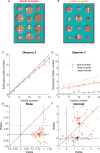Underestimation of the number of hidden objects
- PMID: 36723930
- PMCID: PMC9904329
- DOI: 10.1167/jov.23.2.1
Underestimation of the number of hidden objects
Abstract
The perceptual representation of our environment does not only involve what we actually can see, but also inferences about what is hidden from our sight. For example, in amodal completion, simple contours or surfaces are filled-in behind occluding objects allowing for a complete representation. This is important for many everyday tasks, such as visual search, foraging, and object handling. Although there is support for completion of simple patterns from behavioral and neurophysiological studies, it is unclear if these mechanisms extend to complex, irregular patterns. Here, we show that the number of hidden objects on partially occluded surfaces is underestimated. Observers did not consider accurately the number of visible objects and the proportion of occlusion to infer the number of hidden objects, although these quantities were perceived accurately and reliably. However, visible objects were not simply ignored: estimations of hidden objects increased when the visible objects formed a line across the occluder and decreased when the visible objects formed a line outside of the occluder. Confidence ratings for numerosity estimation were similar for fully visible and partially occluded surfaces. These results suggest that perceptual inferences about what is hidden in our environment can be very inaccurate und underestimate the complexity of the environment.
Figures







Similar articles
-
Electroencephalographic Responses to the Number of Objects in Partially Occluded and Uncovered Scenes.J Cogn Neurosci. 2025 Jan 2;37(1):227-238. doi: 10.1162/jocn_a_02264. J Cogn Neurosci. 2025. PMID: 39436218 Free PMC article.
-
What do we see behind an occluder? Amodal completion of statistical properties in complex objects.Atten Percept Psychophys. 2024 Nov;86(8):2721-2739. doi: 10.3758/s13414-024-02948-w. Epub 2024 Oct 26. Atten Percept Psychophys. 2024. PMID: 39461932
-
Partial modal completion under occlusion: what do modal and amodal percepts represent?J Vis. 2015 Jan 22;15(1):15.1.22. doi: 10.1167/15.1.22. J Vis. 2015. PMID: 25613760
-
Masking unveils pre-amodal completion representation in visual search.Nature. 2001 Mar 15;410(6826):369-72. doi: 10.1038/35066577. Nature. 2001. PMID: 11268213
-
The maintenance and updating of representations of no longer visible objects and their parts.Prog Brain Res. 2017;236:163-192. doi: 10.1016/bs.pbr.2017.07.010. Epub 2017 Sep 12. Prog Brain Res. 2017. PMID: 29157410 Review.
Cited by
-
Electroencephalographic Responses to the Number of Objects in Partially Occluded and Uncovered Scenes.J Cogn Neurosci. 2025 Jan 2;37(1):227-238. doi: 10.1162/jocn_a_02264. J Cogn Neurosci. 2025. PMID: 39436218 Free PMC article.
-
Confidence in auditory perceptual completion.Neurosci Conscious. 2025 Aug 15;2025(1):niaf018. doi: 10.1093/nc/niaf018. eCollection 2025. Neurosci Conscious. 2025. PMID: 40822092 Free PMC article.
-
Implied occlusion and subset underestimation contribute to the weak-outnumber-strong numerosity illusion.J Vis. 2024 Oct 3;24(11):14. doi: 10.1167/jov.24.11.14. J Vis. 2024. PMID: 39417755 Free PMC article.
-
Within-subject confidence intervals for pairwise differences in scatter plots.Psychon Bull Rev. 2025 Aug 28. doi: 10.3758/s13423-025-02750-1. Online ahead of print. Psychon Bull Rev. 2025. PMID: 40877721
References
-
- Anobile, G., Cicchini, G. M., & Burr, D. C. (2014). Separate mechanisms for perception of numerosity and density. Psychological Science, 25(1), 265–270. - PubMed
-
- Binda, P., Morrone, M. C., Ross, J., & Burr, D. C. (2011). Underestimation of perceived number at the time of saccades. Vision Research, 51(1), 34–42. - PubMed
-
- Burnham, K. P., & Anderson, D. R. (Ed.). (2002). Model selection and multimodel inference: A practical information-theoretic approach (2nd ed.). New York, NY: Springer.
Publication types
MeSH terms
LinkOut - more resources
Full Text Sources

